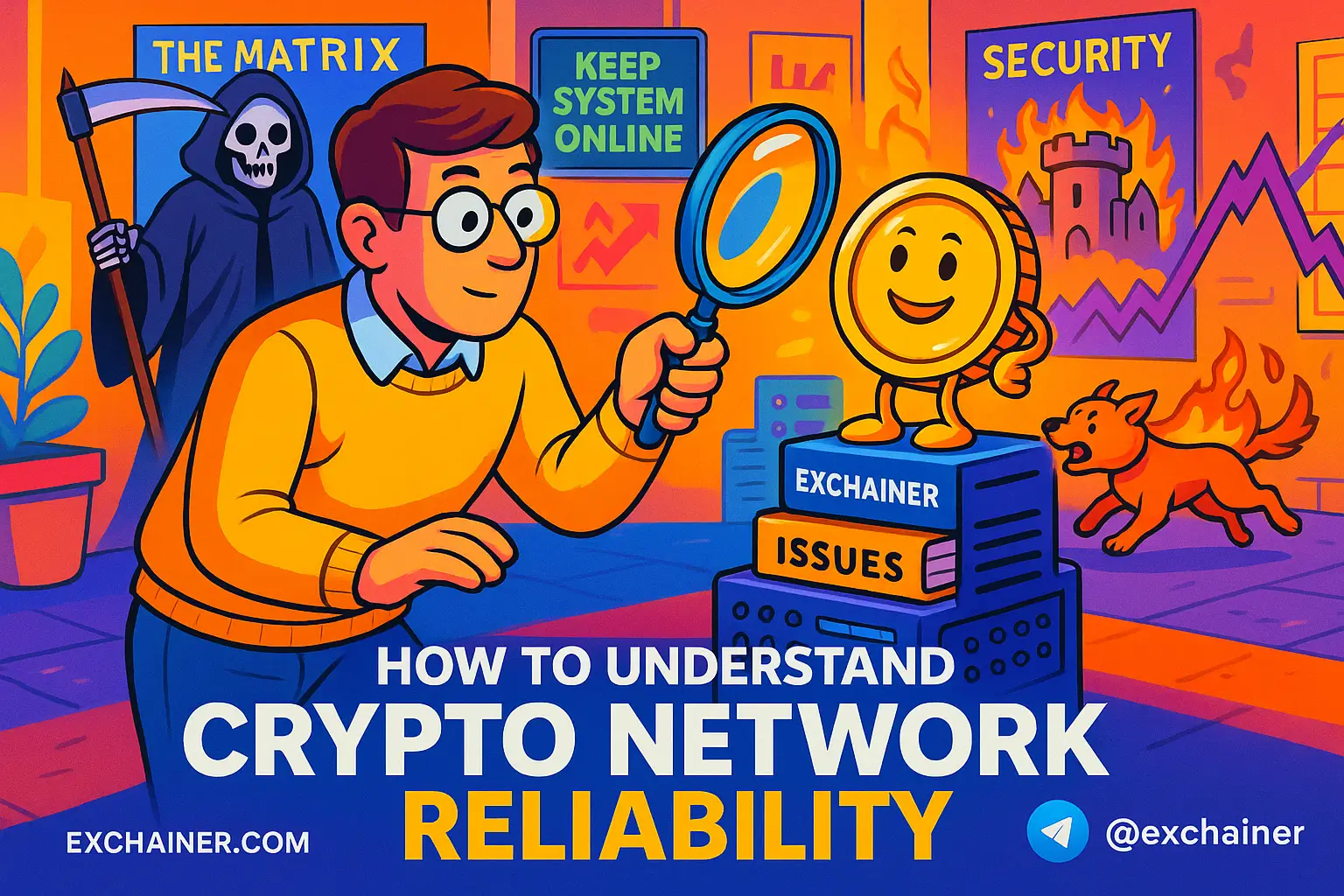Introduction
Friends, imagine you're about to finalize an important DeFi trade or claim your NFT reward, and suddenly the network freezes. Your transaction gets stuck, your funds vanish into limbo, or worse yet, critical on-chain operations fail right when you need them most. This scenario isn't uncommon when we talk about crypto network reliability — a critical factor that underpins everything in decentralized finance, NFTs, and blockchain-based applications today. If you've ever wondered why some crypto projects feel sluggish or unreliable or why funds sometimes don’t show up after a transaction, you're in the right place.
So, what exactly is crypto network reliability? Simply put, it describes how consistently and dependably a blockchain network operates without interruption or failure. In a space booming with DeFi protocols, NFT platforms, and real-time dApps, ensuring your chosen network stays up and running is paramount for developers, investors, traders, and product managers alike. In 2024, with billions of dollars flowing daily across these blockchain ecosystems, poor network reliability doesn’t just cause inconvenience — it can translate into lost money, damaged reputations, and missed opportunities.
In this article, you'll learn how crypto network reliability is measured, understand common reasons behind network failures, discover practical tools and dashboards to monitor blockchain uptime, and grasp how to evaluate a cryptocurrency network’s reliability for your projects or investments. This guide aims to clarify complex concepts like uptime, throughput, transaction failures, and consensus errors in easy-to-follow language, complete with examples and actionable insights.
Whether you're a blockchain developer ensuring your dApp’s smooth operation, a trader wanting to avoid network mishaps, or an investor assessing blockchain platforms, this beginner-friendly breakdown will equip you to make smarter decisions. Curious about “how reliable is Ethereum?” or “how to measure blockchain uptime?” Stick around because you'll find answers and practical tips here.
Our roadmap starts by diving into key reliability metrics, moves to common failure causes, then explores monitoring tools, and ends with strategies for evaluating and securing your crypto networks. Ready to demystify network reliability? Let’s jump in.
Key Reliability Metrics
Understanding crypto network reliability starts with the right metrics. Just like we check internet speed and uptime before trusting a service, blockchain networks must meet certain benchmarks to be dependable. Here are the essential parameters that define blockchain network uptime and overall reliability.
Uptime & Availability
For traditional IT infrastructure, uptime is a straightforward percentage of time a server or service is online. With blockchains, it’s trickier — uptime can be measured at the node level (individual participants maintaining blockchain copies) or the entire network level (consensus across many nodes). For example, if a few nodes go offline but consensus continues, the network might still be operational but with degraded robustness.
High blockchain uptime means blocks are produced and finalized consistently without interruptions. Leading blockchains like Ethereum or Solana typically boast network uptimes above 99.9%, aiming for service-level agreements (SLAs) akin to top-tier cloud providers. For your projects, keeping track of uptime can determine user satisfaction and the opportunity cost of downtime.
Throughput & Latency (TPS and Confirmation Time)
Another key metric is throughput, commonly expressed as transactions per second (TPS). This measures how many transactions the blockchain network can process in a given second. Higher TPS means better scalability and an improved user experience. For example, Bitcoin averages 4-7 TPS, while newer blockchains like Solana claim to handle thousands of TPS. Latency, or confirmation time, is the delay from when a transaction is submitted until it’s officially included in a block. Shorter confirmation times reduce wait times and lower the chance of transaction failures.
Spikes in latency or a sudden drop in TPS often hint at network congestion or underlying issues impacting reliability. If your trades or transfers get stuck because of latency, it’s frustrating, especially during market volatility where every second counts.
Error Rates, Reorgs & Transaction Failures
No network is perfect, but errors need close monitoring. Error rates include failed transactions — either because of dropped messages, insufficient gas fees, or contract execution errors. Chain reorganizations (reorgs) happen when a chain temporarily forks and blocks get replaced, causing temporary instability. Frequent or deep reorgs and repeated transaction failures serve as red flags indicating network instability or even attacks.
For instance, a 51% attack could lead to reorgs that undo confirmed transactions, threatening trust in the system. Tracking these error metrics helps users and developers spot trouble early before losses occur.
Common Causes of Crypto Network Outages
Ever wonder why crypto network outages happen? Let’s break down the typical culprits behind these frustrating events.
Consensus Failures and Attacks
Consensus mechanisms like Proof-of-Work (PoW) or Proof-of-Stake (PoS) ensure all network participants agree on the blockchain’s state. However, if consensus breaks due to forks, chain splits, or attacks like a 51% attack where a malicious actor controls the majority of mining power, the network faces an outage or temporary halt in processing transactions.
For example, during rare but impactful events like a chain split, the network might bifurcate, causing confusion and multiple competing histories. Long-range attacks in PoS chains attempt to rewrite history, threatening reliability and trust.
Node Infrastructure and RPC Bottlenecks
Network reliability depends heavily on robust node infrastructure. When core validator nodes or RPC (Remote Procedure Call) endpoints experience downtime, rate limits, or syncing issues, the network’s accessibility and responsiveness suffer.
Many dApps and wallets rely on centralized RPC providers such as Infura or Alchemy. If these providers face overload or outages, it creates a choke point causing service disruption even if the underlying blockchain operates normally. For developers and traders, node downtime can mean failed or delayed transactions, a painful source of frustration.
Network Congestion, Mempool Overload & Smart Contract Bugs
High-demand periods, such as NFT launches or token sales, can cause congestion, increasing gas fees and delaying transactions. The mempool (waiting area for unconfirmed transactions) can become overloaded with spam or DDoS attacks, slowing block processing and causing backlogs.
Worse, buggy smart contracts with infinite loops or vulnerabilities can bloat the blockchain's state and cause processing delays. These factors collectively weigh heavily on network reliability and user trust.
Measuring & Monitoring Reliability
Keeping tabs on crypto network uptime and performance isn’t just for geeks — it’s a crucial habit for anyone working with crypto. Thankfully, many blockchain monitoring tools can help.
Monitoring Tools and Dashboards to Use
Some popular tools include on-chain explorers like Etherscan that provide block times, transaction status, and mempool statistics. Node monitoring software (e.g., Prometheus + Grafana) tracks validator health, peer count, and sync status.
Third-party dashboards such as Blocknative or Chainbeat offer real-time insights and alerts covering network availability, transaction errors, and gas-price anomalies. Observability stacks help teams quickly identify the source of issues.
Key Metrics to Track and Alert On
To maintain network reliability, it’s smart to monitor:
- Block time variance (are blocks late or missing?)
- Pending transaction count in mempool (rising queues?)
- Peer count (network connectivity health)
- Sync status of validators or full nodes
- RPC error rates and response times
- Gas price spikes or drops indicating congestion
Setting thresholds for alerts helps differentiate normal fluctuations from critical failures. For example, if block time exceeds expected ranges for several blocks consecutively, trigger a high-severity alarm.
Interpreting Alerts and Avoiding False Positives
Not every alert signals real trouble. Distinguishing false positives from genuine incidents requires correlating blockchain signals with infrastructure metrics — did an RPC provider go down or is the network congested? Creating alert runbooks that link symptoms to root causes improves response efficiency and reduces “alert fatigue”.
Evaluating Network Reliability for Decisions
Knowing how to assess crypto network reliability gives you an edge whether you are deploying contracts or investing in tokens.
Analyzing Historical Performance & Outage History
Dig into a blockchain’s historical uptime and outage incidents. Many projects publicly release post-mortems of outages and bugs. Historical data on transaction delays, failed blocks, and reorgs help predict future behavior. For example, Ethereum maintains detailed status pages and community summaries of past network events.
Trade-offs: Decentralization, Security, Scalability
Finding the most reliable network also means balancing decentralization, security, and scalability — the infamous blockchain trilemma. Highly decentralized networks relying on many validators often experience longer block times but provide censorship resistance. Faster networks may centralize validators, risking reliability during attacks or failures. Choose based on project needs — latency may be critical for trading apps, while censorship resistance is paramount for censorship-sensitive projects.
Mitigation & Resilience Strategies for Projects
Projects can bolster network reliability by:
- Using multi-RPC and backup endpoints
- Supporting multi-chain architectures to switch networks during outages
- Employing fallbacks and transaction relayers in dApps
- Crafting custody solutions with failover plans
Such strategies cushion the impact of unforeseen outages and improve uptime.
Conclusion
To wrap it all up, network reliability is the backbone of successful crypto experiences. Understanding key metrics like uptime, throughput, and error rates, recognizing common failure causes, and proactively monitoring networks equips you to avoid surprises and losses. Choosing networks wisely means researching historical performance and balancing the trade-offs of decentralization and performance while implementing failover strategies.
Here’s a quick checklist you can start with today to assess any crypto network’s reliability: check recent uptime data, monitor TPS and latency trends, track failed transaction rates and reorg history, set up alerts using reputable blockchain monitoring tools, and prepare fallback RPC providers or multi-chain support.
If you want to dive deeper or kickstart your crypto monitoring journey, explore blockchain explorers, node monitoring setups, and detailed post-mortem reports for networks like Ethereum or Solana. A practical understanding of crypto network reliability not only safeguards your funds but also empowers you to build and invest with confidence.
Friends, harness the power of monitoring tools and solid evaluation frameworks to secure your crypto activities. Start implementing these strategies now, subscribe for regular updates, and download checklists to stay ahead in the evolving crypto ecosystem.
For more beginner-friendly guides and detailed resources, visit Crypto 101, review trustworthy exchange platforms at Exchange Reviews, or boost your security with our Tools and Wallets category. Your journey to mastering crypto network reliability starts here!












